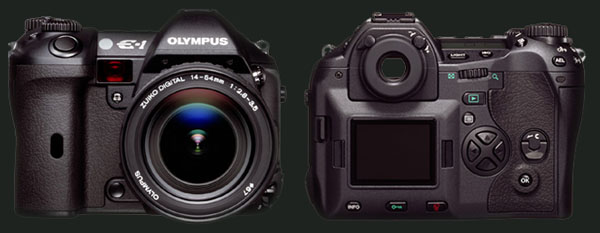
 |
Olympus E-1 Preview |
| August 21, 2003 |
| E-1 Preview • E-1 Preview (continued) • E-1 Preview (continued) • E-1 Specifications
|
No More AA Batteries & No More LiPo! No more leviathon-sized batteries to lug around with the E-1 and its grip accessory. I can't tell you how problematic it was to have such large batteries when I owned an E-10 and the LiPo Grip. Also absent from the other E-series, is the 2 CR-V3 Lithium requirement, which have been replaced with a single 1500mAh Lithium-Ion. Control Cluster
 CF Slot Usually, I wouldn't go into much detail about a CF slot on a professional DSLR, but I would like to mention a few things. I would have preferred a CF slot that opened from the back of the unit, and not from the side. The reason I prefer the opening in the back, is because you won't have to change your grip of the camera with your right hand. Why do you compare the E-1 with the E10/20 cameras? Because the E-1's design is taken directly from it! Olympus even put an online survey, asking specifically, if Olympus users wanted a rangefinder DSLR or one that resembled the E-10. This is probably one of the few times Olympus really listened to its consumer base. Final Thoughts An interchangeable DSLR has finally been offered to dedicated Olympus users. It has been a long wait, and I think overall, it will be worth it. I do have reservations on a few points, which are 1) higher ISO performance, and 2) price. Olympus is asking way too much for a comparible DSLR that sells for $1500. Nikon is reducing the price of the D100 as this preview goes online, and the Canon 300D selling for half the price of the E-1, is giving Olympus a reality check on their $2200 MSRP. I believe the ISO situation can be handled through firmware updates, and if Olympus can sell the E-1 for $1500, they will be properly situated to compete with Nikon and Canon. If they don't, I can't see how a fine camera like the E-1, can even remotely stand a chance of surviving the DSLR Wars. Many cameras have come and gone, and the success to a camera system, is a good introductory deal on the camera, and then paying for the lenses thereafter. If Olympus can give its consumers a deal on the E-1, the lenses will be sought after and Olympus will make a nice chunk of money, while still satisfying its new DSLR client base. Olympus needs to think more towards the future, like they do with their medical products and services. When the E-1 is released, a handful of new DSLRS will be announced as well. A D200 in Spring 2004, the D2h tentatively being released this October, the D2x most likely being announced sometime this year or Jan/Feb 2004, a Fuji S3 coming soon, a few Leica DSLRs, and another Canon DSLR is rumored to be in the works. Olympus faces serious competition. The next DSLR they make, will have to be on the cutting-edge of technology, and even go further. |